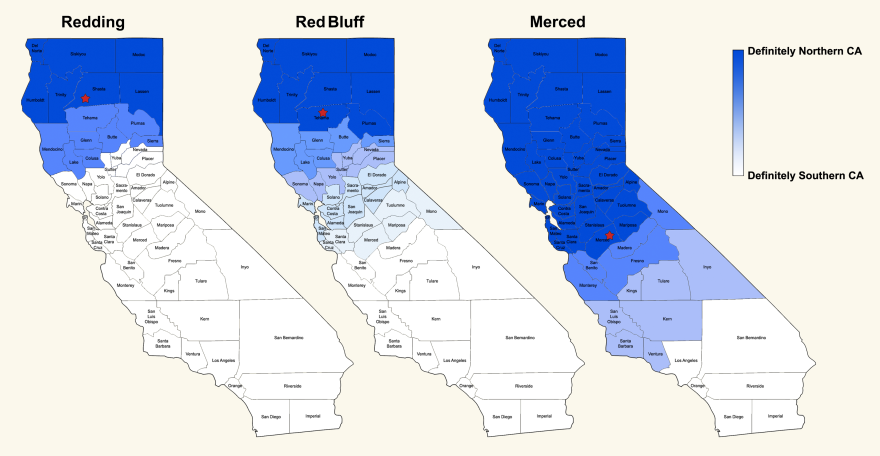"Where exactly is Northern California?" is a question I’ve had since moving from Butte County to Santa Cruz. I remember living there thinking, “Is this still Northern California?” What I learned from Santa Cruz locals was that they did consider themselves to be a part of Nor Cal, but they were quick to tell me that they – unlike so many of the Northern Californians I grew up with – did not use the word “hella.”

Fast forward a decade later and here I am living back in Butte County, but still unsure where exactly that Northern/Southern California line is located. I figured this first episode of Since You Asked was the perfect reason to finally find out.
The first possible answer that popped up in my internet search results was the Northern California Wikipedia page. It claims that Northern California is comprised of the top 48 counties that sit north of the conspicuously straight county lines of San Luis Obispo, Kern and San Bernardino. Sounds straightforward enough, but it’s not true. Neither are many of the other varying theories on the internet about where the north/south California divide is located. I’ve read theories separating the state by physical features, voting history, watersheds, and even by sports fans. Apparently it’s a topic people love to debate. I realized very quickly I wasn’t going to find an easy answer to this question and I needed to reach out to some experts.

Dean Fairbanks is a professor in and the chair of Chico State’s Department of Geography and Planning. He’s author of the book “California Cultural Landscapes: An Exploration of Spatial Patterns Over Time” and said even in the book’s second edition he wouldn’t touch this subject. Why not? Well, maybe that can better be answered by Fairbanks’ students. Fairbanks said each semester he used to ask his students this very question and have them draw their dividing line on a map. While there were some outliers, most of Fairbanks' students separated Nor Cal from So Cal somewhere along the 300-mile stretch between Santa Cruz and Ventura.
“It could be students from Southern California, Northern California, what we think is North and South, coastal interior — it was always that kind of answer,” he said.
And technically all of his students were right. Despite all of the arguments out there, Northern California has no official boundary. It’s what’s known as a vernacular region, which Fairbanks said are very loosely defined and based on people’s perceptions.
“Like do you really know where East LA begins and ends? What is East LA? What is the hood? Well, we call it South Central LA. Where is it really? Define for me where Silicon Valley really is,” he said.
When it comes to regionalization, unless a border has been declared a hard boundary it should instead really be thought of as a transition zone, Fairbanks said.

“And this is a hard thing for the public to understand that everything that we do, when we either crunch the census or let you know what is the habitat boundary for the great spotted owl or for the California condor, boy it looks like it’s a hard boundary, no, it’s pretty fuzzy,” he said.
It gets even fuzzier when you start throwing in the idea that vernacular regions are all about perspective.
Ryan Miller is a project manager at Chico State’s Center for Economic Development and a research specialist at its Geographic Information Center. He’s also an instructor in Chico State’s Department of Geography and Planning where he said he uses Stanford University’s “Voices of California” project to explain this idea to his students.
“Because it really interestingly points to this kind of cultural idea of Northern California – quote, unquote – as this place that’s really exclusive,” Miller said.
What the researchers did, Miller said, was go to the communities of Merced, Red Bluff and Redding and ask them:
“Here’s a map of California. We want you to designate what is definitely Northern California and what is definitely Southern California,’” he said.

What people said depended on where they lived.
Residents in Merced rated themselves and everyone north of them as being definitely in Northern California. They said Southern California started at about Kern County or the Grapevine.
But in Red Bluff survey respondents said, “Northern California actually ends at around Butte County,” Miller said. “So Sacramento, they were rated as definitely Southern California.”
Go north even farther to Redding and survey respondents rated Butte County as possibly being Northern California. But Yuba and Sutter counties were both rated as being definitely Southern California.
“So I think it’s so interesting we talk about this North and South divide, you know where that dividing line is, is completely dependent upon kind of your cultural idea of what your area is,” Miller said.
Define it as where people say the word “hella,” where you need to wear a wetsuit in the ocean in summer, where the palm tree meets the pine, as long as you can argue that there’s some sort of common characteristic within the places where you’d draw your Northern California line you’re pretty much fine wherever you’d put it.



